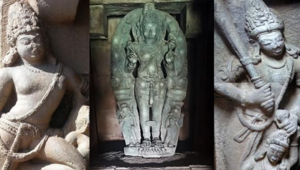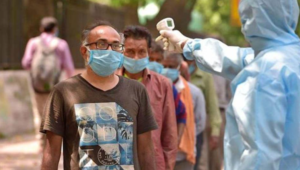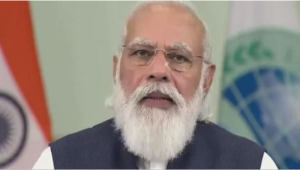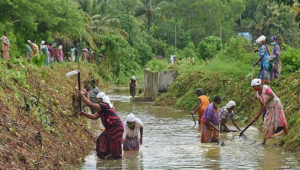
District hospitals have avg 24 beds per 1 lakh people, Bihar lowest at 6: NITI Aayog report.
The NITI Aayog report also shows that in 15 states and UTs, the average number of beds in a district hospital was lower than 22 beds per 1 lakh population as recommended by the IPHS 2012 guidelines.
A district hospital in India has on an average 24 beds per 1 lakh population, with Bihar having the lowest average of six beds and Puducherry the highest of 222, a study conducted by the government’s top think tank NITI Aayog has revealed.
The study – Best Practices in the Performance of District Hospitals – was released on Thursday.
“It is seen that on an average a district hospital in India has 24 beds per 1 lakh population. The Indian Public Health Standards (IPHS) 2012 guidelines recommend district hospitals to maintain at least 22 beds per 1 lakh population (based on district population average of 2001 Census),” states the report, prepared after an assessment of 707 hospitals across 36 states and Union Territories conducted in 2018–19.
It further said, “District hospitals in India have a range of 1 to 408 beds per 1 lakh population. 217 district hospitals were found to have at least 22 beds for every 1 lakh population.”
The findings of the study are significant as it was conducted just before the outbreak of Covid-19. The findings mean that when the country faced the wrath of the pandemic, public health infrastructure, particularly at district level, was not adequate. This was experienced during the second wave of Covid-19, when the country’s health facilities were overwhelmed.

Amarinder Singh says he will leave Congress but won’t join BJP.
On the question of floating his own party, Amarinder Singh’s answer was non-committal and he said people will come to know what happens in future.
Former Punjab chief minister Amarinder Singh on Thursday said he won’t be staying with the Congress, but dismissed speculations of joining the BJP, a day after he met Union home minister Amit Shah at Shah’s residence in New Delhi. The former Punjab chief minister was speaking to a television channel as he said, “So far, I am in the Congress but I will not remain in the Congress. I will not be treated in this manner.” Later, his office issued a statement regarding this.
Amarinder Singh’s media advisor Raveen Thukral also tweeted the interview clippings on his social media handle. On the question of floating a new party, Amarinder Singh said time will tell what will happen. “So you are neither in Congress nor in BJP?” Amarinder Singh was asked. “I have not resigned from the Congress yet but I will resign. I am not one of those who decide on a split second. One has to think of various pros and cons before making a decision. But I can tell you I am not going to stay with the Congress. I am not going to join BJP also,” Amarinder Singh said.
This is the first time that Amarinder Singh talked about leaving the party. His resignation from the post of Punjab chief minister with a few months left for the election was bitter as he said how insulted and humiliated he felt by the treatment of the party high command. However, he never specifically spoke of leaving the party, though he had said he would oppose Navjot Sidhu as the chief minister by fielding a strong candidate against him.
This is the first time that Amarinder Singh talked about leaving the party. His resignation from the post of Punjab chief minister with a few months left for the election was bitter as he said how insulted and humiliated he felt by the treatment of the party high command. However, he never specifically spoke of leaving the party, though he had said he would oppose Navjot Sidhu as the chief minister by fielding a strong candidate against him.
The mid – day meal scheme named has been changed for the PM POSHAN ABHIYAN.
Under the scheme, 24 lakh more children in pre-primary classes, currently covered under the ICDS, will also be brought in. Last year, the government had opened pre-schools called Balvatikas attached to angandwadis.
The mid-day meal scheme will now be known as PM POSHAN, with the Centre initiating a major political push pivoted around ‘child nutrition’, and announcing that around 24 lakh students receiving pre-primary education at government and government-aided schools will also be brought under the ambit of the scheme from next year.
Under the mid-day meal scheme, hot cooked food is provided currently to students from Classes 1 to 8 — around 11.80 crore children in all, in 11.20 lakh government and government-aided schools. Under PM Poshan Shakti Nirman or PM POSHAN scheme, 24 lakh more children in pre-primary classes, currently covered under the ICDS, will also be brought in. Last year, the government had opened pre-schools called Balvatikas attached to angandwadis.
Education Minister Dharmendra Pradhan said PM POSHAN, approved by the Cabinet Committee on Economic Affairs chaired by Prime Minister Narendra Modi Wednesday, will provide a new shape to the policy “to enhance the nutrition levels of schoolchildren”.
Addressing economic challenges by China.
It is the second largest economy in the world after the United States. It is also the third largest importer in the world after United States and Eurozone. It is also the largest consumer of commodities like oil, cement, iron and steel etc.
These credentials make it abundantly clear that the Chinese economy plays a pivotal role in global trade and commerce. In the past one year, this economy has faced a lot of flak. The stock markets have gone to all time lows. The property market is said to be in a bubble and the Chinese economy seems to be crumbling under its own weight.
In this article, we will look at the major issues that are plaguing the Chinese economy.
- Falling Growth Rate:
- Chinese economic growth rate has been unprecedented. The economy has been growing over 10% per annum for a couple of decades now. However, since Chinese economy is centrally planned, this growth rate was planned by the government too.
- Hence, this growth rate was largely fuelled by the very ambitious infrastructure projects that were undertaken by the government of China. However, there is a problem. The infrastructure projects also caused a lot of debt. Over the years, the economy became overburdened with this debt.
- Now since the market sentiment is negative and more debt cannot be added, the growth rate has started crumbling. The most recent statistic has shown growth rate to be close to 6.5% and this has already started causing investor panic based on fears that this number could dip even further if the Chinese are not able to find another cheaper source of funds to fuel their growth ambitions.
- Export Driven Economy to Consumption Driven Economy:
- The Chinese economic miracle was fuelled by the United States consumption debacle. The United States has almost extensively been consuming China’s produce. China has been exporting to a lot of other nations as well. However, United States single handedly accounts for over a third of Chinese exports.
- The United States consumption has been enabled by loose interest rate policies implemented by the Fed. Zero interest rates led to a lot of money floating around. A huge chunk of this floating money ended up being spent on Chinese goods.
- After 8 years of zero interest rate policy, the rates are now set to rise. This is expected to cause a drastic drop in demand in the United States. As a result, Chinese exports will also suffer. Add to this the fact that the economy is already slowing down and we may have a deflationary scenario underway.
- China’s big challenge is to sustain its economic prowess on a domestic economy. Instead of selling to other countries, Chinese businesses now have to sell to each other, if the miracle has to be sustained.
- Manufacturing and Banking Viability:
- The Chinese government central planning has led to a lot of mal investments. This is particularly true in the manufacturing sector. Since the money was loaned out by state banks, the banking system is also reeling under the effects of this problem. The government is currently managing these non performing assets. However, these assets could cause mayhem in the Chinese banking sector. Also, a lot of money has been lent out to developers who have built ghost (uninhabited) towns with it! This money is also unlikely to be recovered. The Chinese banking system could come under a lot of pressure as these NPA’s become certain. The spillover effects of this downturn could be felt in the stock markets as well as across the world.
- Tax Revenues and Expenses:
- A falling GDP also means falling tax revenues for the Chinese government. This becomes a huge problem when one adds the fact that China is a communist country. A centralized economy is based on funds being disbursed from the center. Falling tax revenues and rising expenditures have created shortfalls which need to be filled by borrowing money. Given the debt trap that China may soon find itself in, borrowing is not really a viable option. China will have to figure out other ways to collect more tax or else it may have to cut spending even further causing the GDP to go into freefall!
- Regional Imbalances: Coastal to Internal
- The economic boom has led to widespread development all across China’s coastal periphery. This is obvious given the fact that Chinese growth story was fuelled by exports. Now, since domestic consumption is the key factor, China will have to focus on its severely underdeveloped internal areas. Interior China is still a third world country with low standards of living. This can be viewed as a challenge because sustaining high Chinese growth rates with such poor infrastructure will be difficult to say the least. Also, it can be viewed as an opportunity since developing the internal areas will help give a fillip to the Chinese GDP for several years to come. Thus, there is enough fuel for the Chinese growth juggernaut to continue its run for another year or so.
Defence cooperation will just be handled differently. The Quad wants a positive orientation, rather than be seen as an ‘Asian NATO’.
The institutionalization of the organization has begun and it is a chance for India to work with the advanced economies
The first in-person summit of the Quad powers — Australia, Japan, India and the United States — has clearly advanced the work begun by the virtual summit in March. The September 24 meeting, hosted by U.S. President Joseph Biden, drew global attention both for its symbolism and substance. The photograph showing the four leaders sitting behind separate desks imaginatively placed in a circular format in the elegant East Room of the White House, conveyed a signal of mutual warmth, purpose and resolve. It is necessary to critically analyse the summit’s outcome in order to appreciate the development and formalisation of a new plurilateral and its direction in the coming years.












